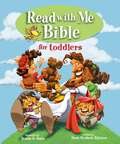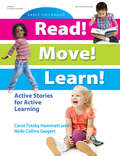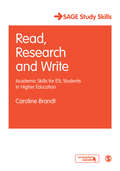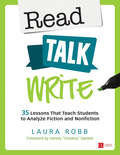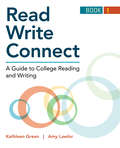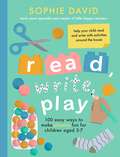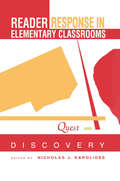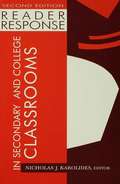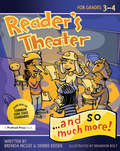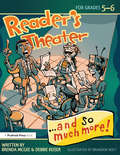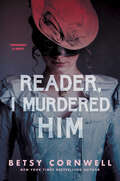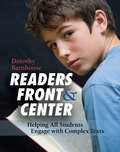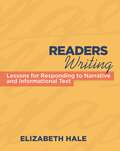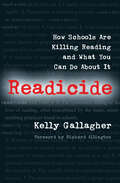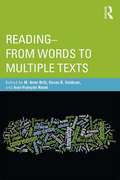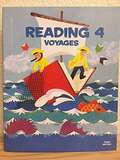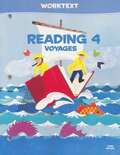- Table View
- List View
Read with Me Bible for Toddlers
by Dennis Jones Doris RikkersThe Read with Me Bible for Toddlers: Children will love it. Vibrant, action-paced full-color art by Dennis Jones brings 24 of the Bible’s best-loved stories to life. Children will love looking at the pictures as you read the delightful simple words and short sentences. Share the excitement of God’s Word with your little one. Give them the Read with Me Bible for Toddlers!
Read! Move! Learn!
by Carol Totsky Hammett Nicki Collins GeigertEnergize your classroom with lively literacy lessons based on more than 70 popular children's books! Enhance literacy skills, bring the magic of a good book to the classroom, and encourage active, healthy lifestyles in young children with Read! Move! Learn!. This book has more than 150 active learning experiences based on popular children's books. In addition to the activities for each featured children's book, you will find theme connections, lesson objectives, a vocabulary list, a concept list, and related children's books and music for hours of fun in the classroom! A few of the children's books included are: Barn Dance Color Dance Head, Shoulders, Knees, and Toes I'm a Little Teapot In the Tall, Tall Grass Monkey See, Monkey Do Quick as a Cricket Teddy Bear, Teddy Bear Ten Terrible Dinosaurs We're Going on a Bear Hunt
Read, Research and Write: Academic Skills for ESL Students in Higher Education (SAGE Study Skills Series)
by Caroline BrandtThis book is for students who have learnt English as a second (or third, or fourth) language, and are studying at an institution where English is the medium of instruction. Each of its 10 chapters focuses on a reproduced academic article on an aspect of English for academic purposes - students can therefore learn about language skills from the articles themselves as well as developing those skills in the activities and tasks which follow. Each chapter develops six strands of academic skills essential for successful study: reading; learning language/vocabulary; writing; researching; studying' and applying to your own subject. The detailed and focused activities and tasks will help you to: - Make reasonable knowledge claims - Become more aware of university culture and expectations - Write according to academic standards - Think critically and reflectively - Respond to ideas in academic articles - Document your work appropriately and avoid plagiarism. Visit the Read, Research and Write Companion Website at www.sagepub.co.uk/brandt Extra downloadable materials include a collection of articles from a variety of different sources related to the topics in each of the book's 10 articles. SAGE Study Skills are essential study guides for students of all levels. From how to write great essays and succeeding at university, to writing your undergraduate dissertation and doing postgraduate research, SAGE Study Skills help you get the best from your time at university.
Read, Talk, Write: 35 Lessons That Teach Students to Analyze Fiction and Nonfiction (Corwin Literacy)
by Laura J. RobbYes—we can have our cake and eat it too! We can improve students’ reading and writing performance without sacrificing authenticity. In Read, Talk, Write, Laura Robb shows us how. First, she makes sure students know the basics of six types of talk. Next, she shares 35 lessons that support rich conversation. Finally, she includes new pieces by Seymour Simon, Kathleen Krull, and others so you have texts to use right away. Read, Talk, Write: it’s a process your students not only can do, but one they will love to do.
Read, Talk, Write: 35 Lessons That Teach Students to Analyze Fiction and Nonfiction (Corwin Literacy)
by Laura J. RobbYes—we can have our cake and eat it too! We can improve students’ reading and writing performance without sacrificing authenticity. In Read, Talk, Write, Laura Robb shows us how. First, she makes sure students know the basics of six types of talk. Next, she shares 35 lessons that support rich conversation. Finally, she includes new pieces by Seymour Simon, Kathleen Krull, and others so you have texts to use right away. Read, Talk, Write: it’s a process your students not only can do, but one they will love to do.
Read, Write, Connect: A Guide To College Reading And Writing
by Kathleen Green Amy LawlorThe first text in a two-part series for the integrated reading and writing course, Read, Write, Connect, Book 1, offers carefully and thoroughly integrated instruction for reading and writing at the paragraph-to-essay level. With scaffolded pedagogy and a flexible structure that reflects the recursive nature of reading and writing processes, the text allows instructors to easily differentiate instruction to meet the needs of all students. It offers intensive practice in the basic skills of reading comprehension and summary writing, and then helps students build on those skills to respond to texts critically and analytically in their own college-level paragraphs and short essays. <P><P> LaunchPad Solo for Readers and Writers can be packaged with Read, Write, Connect, Book 1 at no additional cost,, allowing you to more efficiently track students’ progress with reading, writing, and grammar skills in an active learning arc that complements the book.
Read, Write, Play: 100 Easy Ways to Make Phonics Fun for Children Aged 3-7
by Sophie DavidUnlock the joy of reading and writing with Read, Write, Play, a hands-on guide featuring 100 fun and engaging activities that support children aged 3-7 on their phonics journey.Whether you're supporting school lessons or starting at home, this book provides all the guidance you need - with no prior knowledge of phonics required. It is the perfect resource for parents, carers and educators who want to transform phonics into a playful, accessible adventure.Children learn best through play, and every activity in this book is designed to be fun and quick to set up, using common household items like paper cups and craft sticks. These multi-sensory and adaptable activities cater to all learning styles, making phonics enjoyable and rewarding for every child.Covering all six phases of the phonics curriculum, it starts with pre-reading skills and progresses to advanced topics like irregular plurals and suffixes. Clear explanations and tailored activities ensure children can build their skills confidently at their own pace.Phonics doesn't have to be daunting. With Read, Write, Play, it can be playful, memorable and even magical.
Read, Write, Play: 100 Easy Ways to Make Phonics Fun for Children Aged 3-7
by Sophie DavidUnlock the joy of reading and writing with Read, Write, Play, a hands-on guide featuring 100 fun and engaging activities that support children aged 3-7 on their phonics journey.Whether you're supporting school lessons or starting at home, this book provides all the guidance you need - with no prior knowledge of phonics required. It is the perfect resource for parents, carers and educators who want to transform phonics into a playful, accessible adventure.Children learn best through play, and every activity in this book is designed to be fun and quick to set up, using common household items like paper cups and craft sticks. These multi-sensory and adaptable activities cater to all learning styles, making phonics enjoyable and rewarding for every child.Covering all six phases of the phonics curriculum, it starts with pre-reading skills and progresses to advanced topics like irregular plurals and suffixes. Clear explanations and tailored activities ensure children can build their skills confidently at their own pace.Phonics doesn't have to be daunting. With Read, Write, Play, it can be playful, memorable and even magical.
Reader Response in Elementary Classrooms: Quest and Discovery
by Nicholas J. KarolidesReading is a quest. Likened to an adventure -- both metaphoric and real -- the quest is a journey of discovery. The reader's search encompasses the sensations of the experience itself, accompanying emotions, sense and meaning engendered by the experience, and understandings of the self, others, and the world around. Out of curiosity, readers also search for an extensive array of information. The journey can be envisioned and contemplated again and again after the reading act itself is completed. In a meaningful way, the reader's quest and its discoveries are life enduring and life fulfilling. The purpose of this volume is two-fold: * to establish and explore the essential features of reader response theory and its rendering of the reading process, and * to acknowledge a philosophy of teaching and to illustrate teaching strategies to evoke and enhance readers' responses. Understanding the ways in which the reader affects the reading and how the reading happens will illuminate classroom pedagogy. This text establishes and explores the essential features of reader response theory and its rendering of the reading process. The essays acknowledge a philosophy of teaching and illustrate a spectrum of teaching strategies to evoke and enhance readers' responses, including whole and small-group discussion; story drama; readers' theatre; journal writing; scripts, letters, stories, and other writings; and "body punctuation." A case study format is used to illustrate these strategies in action in real classrooms.
Reader Response in Secondary and College Classrooms
by Nicholas J. KarolidesThis text, based on Louise M. Rosenblatt's transactional model of literature, focuses on the application of transactional reader-response theory in the classroom. It grows from frequent requests from secondary school and college teachers for teaching suggestions on how to put theory into practice. This is not a "What should I do on Monday?" cookbook, but an expression of the practice of theory in college and secondary school classrooms. The chapters portray a spectrum of strategies--including biopoems, expressive and imaginative writing, journal writing, readers' theater, role playing, and unsent letters--using as examples individual works from several genres. Recognizing that teachers who may have been trained in other theories and methodologies may be hesitant about their quite different role and expectations in the reader-centered classroom, the authors provide stepping stones to develop readiness and confidence, suggestions, and insights to ease the transition to the transactional model of teaching and learning. Pedagogical features: * An explanatory introduction to each section defines its orientation and describes the content and direction of the chapters it contains. * Invitations elicit engagement of readers with concepts, attitudes, or strategies presented in the chapters; they invite readers, as individuals or members of a small group, to consider ideas or to practice a strategy, among other activities, in order to enhance understandings. * A glossary defines key concepts and strategies discussed in the text. * A bibliography provides an extensive list of resources--books and journal articles--both theoretical and applied. New in the second edition: * Six new chapters--three deal with the roles of film-as-literature in the English classroom, and three with enhancing multicultural understandings. * Updates and revisions to several chapters that appeared in the first edition. * Invitations, new in this edition, have been added to focus and expand readers' thinking.
Reader's Theater...and So Much More!: Grades 3-4
by Brenda McGee Debbie Keiser TriskaReader's Theater . . . and So Much More! is written for grades 3-4. This exciting resource contains plays, skits, and independent research activities with an innovative twist for differentiated instruction. This high-interest book of humorous skits and plays is a jumping-off point for research and creativity for students of all ability levels. Each of the reader's theaters comes with suggestions for differentiating and extending the lesson's content. These plays not only provide a legitimate reason for students to reread texts and practice fluency, but they also promote cooperative interaction with peers.Grades 3-4
Reader's Theater...and So Much More!: Grades 5-6
by Brenda McGee Debbie Keiser TriskaReader's Theater . . . and So Much More! is written for grades 5-6. This exciting resource contains plays, skits, and independent research activities with an innovative twist for differentiated instruction. This high-interest book of humorous skits and plays is a jumping-off point for research and creativity for students of all ability levels. Each of the reader's theaters comes with suggestions for differentiating and extending the lesson's content. These plays not only provide a legitimate reason for students to reread texts and practice fluency, but they also promote cooperative interaction with peers.Grades 5-6
Reader, I Murdered Him
by Betsy CornwellIn this daring tale of female agency and revenge from a New York Times bestselling author, a girl becomes a teenage vigilante who roams Victorian England using her privilege and power to punish her friends&’ abusive suitors and keep other young women safe. Adele grew up in the shadows—first watching from backstage at her mother&’s Parisian dance halls, then wandering around the gloomy, haunted rooms of her father&’s manor. When she&’s finally sent away to boarding school in London, she&’s happy to enter the brightly lit world of society girls and their wealthy suitors. Yet there are shadows there, too. Many of the men that try to charm Adele&’s new friends do so with dark intentions. After a violent assault, she turns to a roguish young con woman for help. Together, they become vigilantes meting out justice. But can Adele save herself from the same fate as those she protects? With a queer romance at its heart, this lush historical thriller offers readers an irresistible mix of vengeance and empowerment.
Readers Front and Center: Helping All Students Engage with Complex Text
by Dorothy BarnhouseEvery teacher wants and expects his or her students to be reading increasingly complex texts, yet sometimes the gap between our expectations and our students' abilities seems wide and deep. It's tempting to look at that gap and step in to fill it for them, but then we'd be doing most of the heavy lifting the understanding, analysis, and interpretation that our students should be learning for themselves. So how can teachers reverse this trend and ensure that our students are fully entering, absorbing, and experiencing texts? How can we make sure they're making complex meaning independently and proficiently,- as the Common Core State Standards require? Readers Front & Center answers these questions by framing instruction that starts with the student. You'll learn how to do the following: Research and listen to your students so your teaching can be more targetedNotice and name your students' thinking so they can see- what complex thinking looks and sounds likeSet your students up to be problem solversPrepare your students to do increasingly complex thinking in increasingly complex texts Filled with examples of one-on-one conferences, small groups, and whole-class scenarios, this essential book provides an accessible and inspiring model of how-;and why-;we need to put students at the front and center of our teaching.
Readers Writing: Strategy Lessons for Responding to Narrative and Informational Text
by Elizabeth HaleWhen faced with a blank page in their readers' notebooks, students often fall back on what is familiar: summarizing. Despite our best efforts to model through comprehension strategies what good readers do, many students struggle to transfer this knowledge and make it their own when writing independently about books. Readers Writing,' Elizabeth Hale offers ninety-one practical lessons that show teachers how students of all ability levels can use readers' notebooks to think critically,' on their own,' one step at a time. Each of the lessons uses a fiction or nonfiction book to address a comprehension strategyquestioning, connecting, analyzing, synthesizing, evaluating, visualizing, or monitoringby showing students one specific way they can write about their thinking. Each lesson also provides an example of how to model the strategy. All of the lessons follow a similar format with five componentsName It, Why Do It?, Model It, Try It, and Share Itand include time for students to actively process what they learn by talking about and trying out the strategy in their readers' notebooks. Elizabeth also provides suggestions for supporting student independence, managing independent writing time, scaffolding comprehension of nonfiction texts as well as assessing and conferencing with readers' notebooks. Helpful appendices include a table that illustrates how each lesson aligns with the Common Core State Standards and a list of additional titles that can be used to demonstrate each of the ninety-one lessons. ' ' ' ' ' Readers Writing' gives teachers a way to engage all children with readers' notebooks, to learn the language of thinking, one strategy at a time, and to become lifelong readers who can think and write critically on their own.
Readicide: How Schools Are Killing Reading and What You Can Do About It
by Kelly GallagherRead-i-cide: The systematic killing of the love of reading, often exacerbated by the inane, mind-numbing practices found in schools. Reading is dying in our schools. Educators are familiar with many of the factors that have contributed to the decline, poverty, second-language issues, and the ever-expanding choices of electronic entertainment. In this provocative book Readicide: How Schools are Killing Reading and What You Can Do About It , author and teacher Kelly Gallagher suggests it is time to recognize a new and significant contributor to the death of reading: our schools. Readicide , Gallagher argues that American schools are actively (though unwittingly) furthering the decline of reading. Specifically, he contends that the standard instructional practices used in most schools are killing reading by:Valuing standardized testing over the development of lifelong readersMandating breadth over depth in instructionRequiring students to read difficult texts without proper instructional support and insisting students focus on academic textsIgnoring the importance of developing recreational readingLosing sight of authentic instruction in the looming shadow of political pressuresReadicide provides teachers, literacy coaches, and administrators with specific steps to reverse the downward spiral in reading-;steps that will help prevent the loss of another generation of readers.
Readiness for Religion: A Basis for Developmental Religious Education (Routledge Library Editions: Education and Religion #5)
by Ronald GoldmanIn this study, first published in 1965, the author explores the implications of research for an alternative approach to religious education. The book deals with the psychological bases of religious development, reviewing the natural limitations as well as the basic needs of the young, and how religious education should be affected by educational theory and practice. The author also examines what content and methods of teaching are consistent with the healthy development of children and adolescents. Teachers in schools, students in training, lecturers, clergy and ministers, and local education authority committees will welcome the book as an important aid to the task of rethinking syllabuses and the need for more child-centred methods of teaching.
Reading - From Words to Multiple Texts
by Jean-François Rouet M. Anne Britt Susan R. GoldmanIncreasing the mastery of reading and text literacy in the general population is one of the most important challenges faced by both developed and developing societies. Providing a new reference for researchers and practitioners involved in this domain, this book brings together empirical research on the multiple levels of language that are involved in reading. It emphasizes the concrete outcomes of scientific research, and illustrates the continuity among levels. The chapters deal with clearly articulated questions, provide up-to-date reviews of the literature, and include discussions of the impacts of research outcomes for the practice of reading instruction. Furthermore, the volume addresses the gap between restricted and more functional approaches to reading competency. Finally, it addresses some of the new issues that arise from the rapid changes in reading practices that are related to the diffusion of digital technologies. Featuring contributions from authors who are among the acknowledged leaders in the field and presenting the state of the art and current controversies in reading and literacy research, this volume honors the profound impact of Charles Perfetti on reading research.
Reading 2004 Practice Book Grade 6
by Scott ForesmanScott Foresman Reading ((c)2004) components for Grade 6.
Reading 4 Christian Schools: I Met You In A Story (Second Edition)
by Dorothy BuckleyStories, poetry and folktales from around the world.
Reading 4 Voyages Worktext
by Bju PressThis BJU Press Reading 4: Voyages Student Worktext is designed to be used alongside the Reading 4: Voyages Student Text, 3rd Edition (not-included and sold-separately). It provides opportunities for students to more deeply engage with the text through fun activities and exercises that review the vocabulary, skills, concepts, and literary elements from the reader. Students will study story structure, complete graphic organizers, complete map work, answer comprehension questions and personal reflection questions, finish word puzzles/games, and more.
